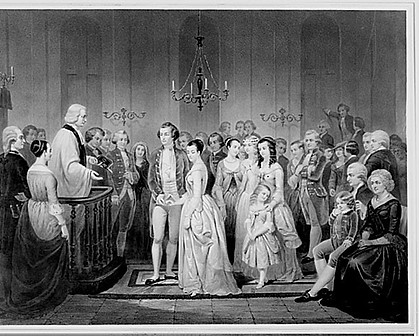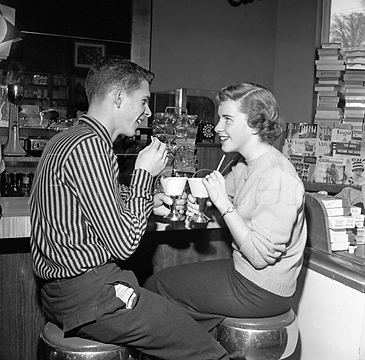Lesson One
The History of Dating
Why should we study history? Some might argue that we shouldn’t. History is in the past and should stay there. But is there any real value to understanding history? The American Historical Association boldly states that, “Only through studying history can we grasp how things change; only through history can we begin to comprehend the factors that cause change; and only through history can we understand what elements of an institution or a society persist despite change” (4).
The question could be posed then, what can history tell us about dating practices? We believe that when we understand how and why certain elements of dating change, we can better understand what we can do about the change, how to adapt to the changes, and maybe how to make a few changes of our own.

Before the 18th Century
Prior to the 18th century the idea of dating and love didn’t exist in society. Marriage was the only viable option for young people and the institution of marriage was considered solely an economic and political transaction between two families. Love wasn’t seen as a reason to get married because society didn’t see love as necessary for a marriage to work. What was valued in a potential spouse was the resources, wealth, or skills that they could bring to a marriage (3).
18th Century
Beginning in the 18th century mate selection changed. The rise of the Industrial Revolution changed how young people earned money. Men no longer had to wait to receive an inheritance or the family business because they could earn their own wages at a younger age. This shift to livable wages began to separate the parents from the mate selection process.
Towards the end of the 18th century, influential writers of the Enlightenment changed the way young people viewed marriage. The push for individual rights and happiness added the element of choice to the process of marriage. People could now choose to marry for love. The measure of success for a marriage in this century was how well the couple met the each other's emotional needs (3).
“You engross my thoughts too intirely to allow me to think of any thing else—you not only employ my mind all day; but you intrude upon my sleep. I meet you in every dream—and when I wake I cannot close my eyes again for ruminating on your sweetness.”
—Alexander Hamilton to Elizabeth Schuyler, October 5th, 1780
Questions to Consider
-
Why should we study the history of dating?
-
What can we learn from the past that can help us in the future?
19th Century
The early 19th century saw the beginning of courtship. “Courtship involved one man and one woman spending intentional time together to get to know each other with the expressed purpose of evaluating the other as a potential husband or wife” (1). Men could pick a woman in which he had interest in marrying and spend time with her prior to the marriage usually inside the woman’s home. However, there were specific societal rules about which women men could visit and there always had to be a chaperone with the couple supervising the visit. There were also restrictions based on social class and family connections about who was an appropriate potential spouse.

Questions to Consider
-
If the Industrial Revolution and Enlightenment had not occurred, do you think that people could still marry for love today?
-
Are there any benefits to arranged marriages? Why or why not?
20th Century
1920’s: During this time period the development of dating occurred. This was the first time in history when mate selection happened outside of the home. Marriage was still an important aspect of life to young people, but they wanted to find more love and sexual satisfaction in marriage. Because of this, dating practices arose in attempt to meet those expectations (2).

1930’s-1940’s: The Great Depression in the 1930’s changed the dating practices that began in the 1920’s. Dating was not as much of a concern during The Great Depression. People were more focused on finding a mate to help them survive physically and financially as opposed to finding a mate that met their emotional or sexual needs. In the 1940’s dating was not re-established because of World War 2. Many eligible men were off fighting in the war, and many women were obligated to the workforce instead of marrying (2).
1950’s: During this time, the idea of dating reemerged, but it looked different than it did before. The aftermath of World War 2 saw fewer men returning home to their families. This led many young adults to start dating and marrying at younger ages. The idea of “going steady” also emerged during this decade. Many young adults began exclusive serious relationships but not with the intent to marry later (1).
1960’s-1970’s:
During this twenty-year period the Women's Revolution and the Sexual Revolution fundamentally changed the ideas of dating and marriage. People started having a desire to be self-fulfilled and develop an individual self apart from their intimate relationships. The expansion of the free love moment and the introduction of the birth control pill led young adults to separate the idea of sex and marriage. With this separation, premarital sex became socially acceptable (2).
1980’s-Today: The values that became important in the 1960’s-1970’s continued to become socially and legally acceptable throughout America. Divorce rates rose and cohabitation rates followed. Fewer people marry today, yet young adults still have a desire to get married when they get older.Dating practices have drastically changed in recent yeas to what has come to be commonly known as the Hook-up Culture.

Conclusion
Now that we have briefly discussed the history of dating, how have you seen dating change throughout time? Did you notice any common themes in the different changes? One of the themes that we noticed is that sexual activity outside of marriage has become more and more common especially now that love plays such a big role in dating practices. Could there be any consequences to this change?
As we mentioned at the beginning of the lesson, learning about the history of courtship and dating can help us understand how and why changes have occurred. Armed with this understanding, we can explore further today’s dating practices and try to answer the questions: Is the current Hook-up Culture good for couples and society? If not, what can we do about it? Should we do anything? On to lesson two...The Hook-up Culture.
Questions to Consider
-
What contributed in the changes in dating practices?
-
Are these changes good or bad? Why or Why not?
References
1. Burzumato, S. (2018, September 11). A Brief History of Courtship and Dating in America, Part 2. Retrieved from https://www.boundless.org/relationships/a-brief-history-of-courtship-and-dating-in-america-part-2/
2. M. Cancian."From Role to Self: The Emergence of Androgynous Love in the Twentieth Century,” from Love in America: Gender and Self-Development, pp. 30-45. 1987 Cambridge University Press.
3. Coontz, S. (2005). Marriage, A History, How Love Conquered Marriage. New York, New York: Penguin Group.
4. (n.d.). Retrieved from https://www.historians.org/about-aha-and-membership/aha-history-and-archives/historical-archives/why-study-history-(1998)